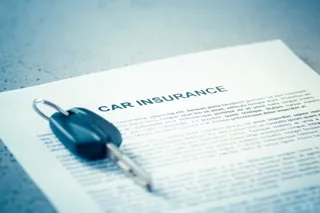There are two ways to handle the many elements of operating a fleet: to bundle services with a leasing provider – if that is your chosen funding method – or to unbundle them.
Bundling pulls together funding, SMR and management services under one supplier, and is the approach favoured by most companies that lease vehicles.
FN50 data shows that 61% of cars and 59% of vans are on a ‘with maintenance’ contract. However, those proportions are in slight decline: three years ago, they were 63% (cars) and 62% (vans).
A number of companies have opted to unbundle their fleet services. But is it the right option for your business?

“The benefit (from bundling) for the business is it has a one-stop shop for all the services, one contact point and one supplier invoice, which frees up the time to be strategic,” says Sean Bingham, consultant at ERA Fleet Cost Management.
“All the information is in one place and there is comprehensive management information.
“You can also negotiate better terms and conditions when you package everything together because a leasing company has extra revenue coming in on ancillary services. But, if a leasing company doesn’t provide a servicing and maintenance charge, there may be a higher cost on finance.”
Conversely, unbundling allows the appointment of a number of suppliers for requirements that include finance, servicing, maintenance, repair, tyres and so on.
Services can be divided into lots with suppliers bidding, according to their strengths.
This does not have to be a fragmented approach; it could mean a company unbundles funding and appoints a panel of providers, whose contracts are run by one overarching contractor such as a fleet management company.
The client retains control because contracts are awarded based on its criteria and the fleet management company gathers information from the contracts to present a complete picture to the client.
They derive best cost for each vehicle because they are paying only for the cost incurred for the servicing work (pay as you go/PAYG), provided they can negotiate competitive labour rates, parts pricing, etc.
However, Bingham says that companies which unbundle services to manage suppliers directly need to keep up-to-date because the market is ever-evolving.
“They need to know what is a reasonable price for everything; they would need service level agreements (SLAs),” he adds.
Bundling fleet services is most popular where the role of fleet manager sits in procurement or finance.

Matt Dale (above), head of consultancy for ALD Automotive, says: “Procurement, typically, increases the weighting on cost over service. So, sole supply is still prevalent, as it can attract the short-term financial and administrative gains required.
“However, large fleets may also opt to engage one supplier for fleet management services and use the supplier’s purchasing power to unbundle funding to a panel of providers competing for each order. This can provide savings over the longer term.”
With everything bundled into one place, the benefit of working with one supplier is ease of administration, simplified processes and consistency of management information.
Andrew Goodwin, sales director of BT Fleet Solutions, says: “For customers with more complex car policies and a wider choice of vehicles and extras, working with one supplier enables full outsourcing of the driver quote, order and management process.
“In addition, customers choose single-source relationships because of the perceived added value in areas such as developing policy with a chosen partner and working to deliver strategic projects like cost reduction.”
PD Hook (Hatcheries) has 120 cars and 180 vans, all on contract hire with one of two leasing companies. “I get a quote and balance them out, so have roughly half and half, on full service,” says Nigel Boyle, its administration and technical director.
Drivers use garages approved by the leasing company and tyres are handled by Kwik Fit Mobile, which turns up on the agreed day with the appropriate set.
Costs for contract hire are set, one figure for finance, one for service, maintenance and repair (SMR), and the leasing company keeps the records.
“The advantage of having it all with a leasing company is that we vary the term of contract hire according to the mileage covered – drivers send the mileage in each month, so we know what they are doing,” Boyle says.
Fleet management companies cite the advantages of unbundling as having greater transparency, control and the ability to take a holistic view in order to find efficiencies.
“Historically, organisations would bundle services into one place in the knowledge that everything was wrapped into that one rental,” says Jason Chamberlain, sales and marketing director of ARI.
“But you don’t get true visibility of what makes up that cost, which removes any option to provide efficiencies or cost savings.
“Our customers demand every line item of cost because they want to track trends and individuals’ behaviour, so they can see how to mitigate expenditure and shape strategy.”
For some organisations, a fixed fee per vehicle per month is preferable, particularly where they are working on contracts through central government and need to write in their overheads.
ARI attempts to give the best of both worlds. “For example, if we billed for SMR for a vehicle aged more than 48 months and the vehicle incurred only two-thirds of that cost, we can refund 100% of underspend.
"That’s unique and gives a budgetary tool when costs are allocated to cost centres,” Chamberlain says.
The converse is also true. “While contract hire offers the benefit of risk transfer and monthly budgets, these bundled lease arrangements are not always equitable at the end of the contract as many fleets do not benefit from profit share arrangements for residual values (RVs) or underspent maintenance budgets,” says Goodwin.
The alternative is pay-as-you-go (PAYG), but that can present its own challenges. “There could be a need for a fleet to manage a one-off high expense such as an engine blowing up, which has a bigger impact on a small fleet of less than 100,” says Bingham.
“PAYG is often cited as cheaper. When you put a new vehicle on the road, the running cost is lower than in subsequent years – the replacement cycle of vehicles is an important factor in that.
"But, steadily, costs start to increase, not just servicing but tyre wear and tear, drive-chain requirement, etc. Critical is the internal skill resource to manage in-life operation and a lot of corporate UK does not have dedicated resources.”
Nevertheless, maintenance management is one area fleet management company CLM recommends for unbundling.
“Our analysis shows that savings of around £800 per vehicle contract are possible by switching from fixed cost maintenance to PAYG,” says managing director John Lawrence.
“Between May 2017 and May 2018, we saved one client more than £40,000 on maintenance alone.”
CLM gives drivers access to a national network of preferred garages, which combine franchised, non-franchised and mobile repairers.
Costs are pre-authorised against agreed labour and parts charges and are validated, consolidated and analysed.
“We can also make a strong case for unbundling vehicle acquisition and employing several contract hire suppliers to provide all new vehicles, which ensures the most competitive solution,” Lawrence says.
In the past, unbundling largely worked for fleets of more than 500 vehicles but, more recently, companies have seen the advantages start at around 100, particularly where vehicles are a tool of the trade.
Organisations are having to do more with less but still need the copious amounts of data supplied by telematics and repair records in order to see vehicle compliance, fuel figures, accident data and more.
“They are looking for technology to aggregate and harmonise all that information and provide them with insight, so in the past five years we have invested in the technology to do that and allow companies to build a fleet strategy to align to their business plans,” says Chamberlain.
ARI recently won the business of a large utility company with more than 4,000 vehicles, which had been with one provider for 10 years and moved to breaking services into lots with a central contractor to “glue together all the requirements of end-to-end service delivery”.
A long-standing agreement with one supplier often raises a problem: rental creep.

“With one leasing company tied into a lengthy contract, there is no measure,” says Jayne Pett (above), sales and marketing director for Fleet Operations. “It is creating a rental when requested and if it is putting in extra profit, there is no evidence.
“Where companies want to remain with a sole provider, we mark the homework of that leasing company. We check invoices and when it comes to quoting, although we wouldn’t be placing orders with other leasing companies, we would measure the rate they would have quoted for the same vehicles.”
Putting the bid to a number of suppliers has the advantage of injecting competition.
“Every time a quote goes out for a vehicle, a vendor looks at it as a new business quote,” Pett says. “We do see an 8% to 10% saving if we look at a panel of vendors.”
Even for organisations not looking to unbundle their fleet management, certain elements lend themselves to it. Pett recommends risk and compliance.
“They are a huge thing for businesses and with the best will in the world, a leasing company’s core day-to-day practice is about finance, funding vehicles. It is rare to find expertise in managing risk and compliance, but, by unbundling, you pick up those skillsets,” she says.
The cost implication of bringing in a fleet management company is the management fee per vehicle per month but “if you look at the return on investment, the savings far outweigh the fee”, says Pett.
“Part of the fleet management cost covers ongoing consultancy and negotiations; they manage your contracts.”
John Webb, principal consultant for Lex Autolease, is a protagonist of bundling. “It is about organisational strategy and support services,” he says.
“Bundling allows companies to concentrate human assets on core business services and not devote too many resources to managing supply chains; there is a lot to be done in an unbundled environment.”
And more tasks associated with fleet management means a requirement for more internal resources.
“In a bundled environment, a first tier supplier and strategic partner manages the rest of the supply chain, so all activity is being channelled through them,” he says.
“The obligation is then on the buyer to make sure that the tender, contractors and SLAs give value for money and the level of service they are looking for.
“With organisations like Lex Autolease, buyers get economies of scale – it’s our area of expertise. In a fully outsourced environment, typically, one or two people look after the relationship and handle as many as 10,000 vehicles.”
Data and management information (MI) are another reason for bundling services because a leasing company with hundreds of thousands of vehicles can benchmark cost, so customers can see when they are out of line.
Having a bundled, one-stop-shop arrangement does not preclude competition and gives companies one contact number and a central repository for management information.
But unbundling does not have to be a scattergun approach if the component parts are managed by one principal supplier.
There are financial and administrative advantages to both methods. Often, the choice comes down to company culture.
Case study: Aviva

Aviva identified an opportunity to get better value out of disparate contracts like hire cars, pool car management and lease vehicles by bundling them when it went to tender.
“This meant suppliers were acting more as strategic fleet partners; it was all part of the contract for total fleet provision: accident management, breakdown recovery, telematics, daily rental, reallocation of pool car management and their bread and butter, lease vehicle provision and how they source that,” says Ryan Coles (above), group travel and fleet manager, Aviva.
“This arrangement allowed us to get more control over daily rental car damage, where it is very difficult to prove liability; we instructed LeasePlan and (incident management specialists) FMG to investigate that on our behalf.
“We have negotiated a rate across our daily rental programme that reflects our volumes and the value of our lease programme. We still want to make sure that the service we get for that money is top notch; we are not penny pinching, we want value for money.
“We also asked them to create a risk profile of our drivers. This requires taking data feeds from LeasePlan daily rental, FMG accident management and telematics to understand what the true cost of a particular driver is to Aviva.
“Our drivers have a low risk profile. We have an essential user programme and with the manufacturers we have on the programme, our drivers are proud to be in those vehicles, so they tend to look after them particularly well.
“Bundling allows us to take that behaviour from lease and put it into our daily rental and this has reduced expenditure.
“We used to have a fleet team in the UK of around five people and now we have a UK & Ireland travel and fleet team of 2.8 FTE (full-time equivalent), including me in a global role.
“It has allowed us to reduce internal resource requirement and use the relationships with LeasePlan, the manufacturers and Jardine Matheson Lancaster Group to be our subject matter experts; we are the relationship and contract management team that makes sure they are delivering to our customers what they should be as a total fleet management solution.
“Giving LeasePlan responsibility for operational requirements allows us to operate more strategically with our lease partner to give the best advice to our drivers in terms of vehicles that are available, the impact of WLTP and the unknown element of 2021 tax rate.”



















Login to comment
Comments
No comments have been made yet.